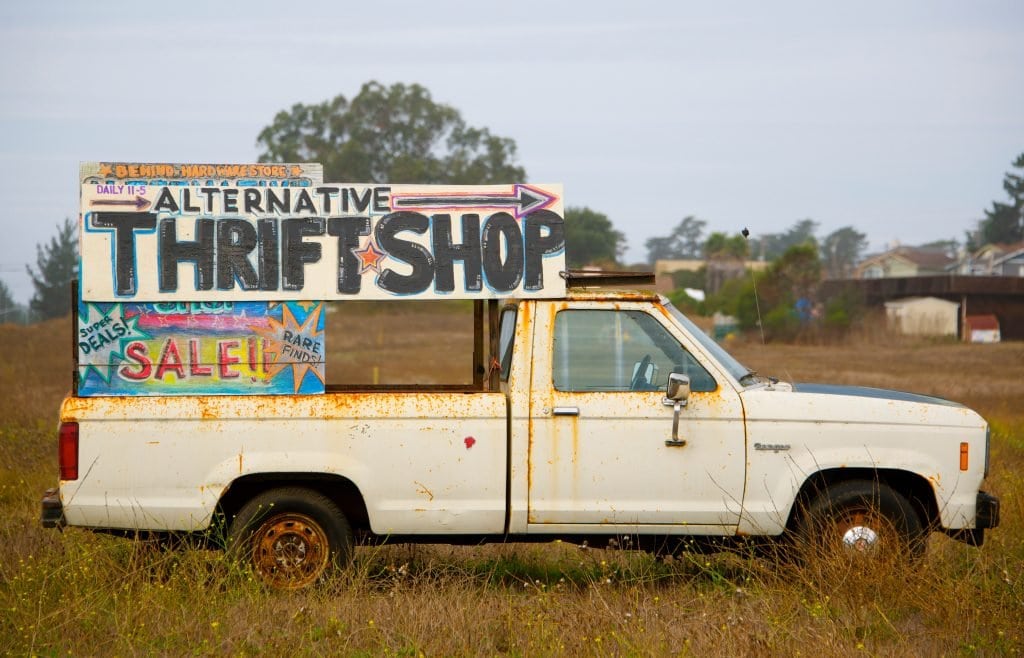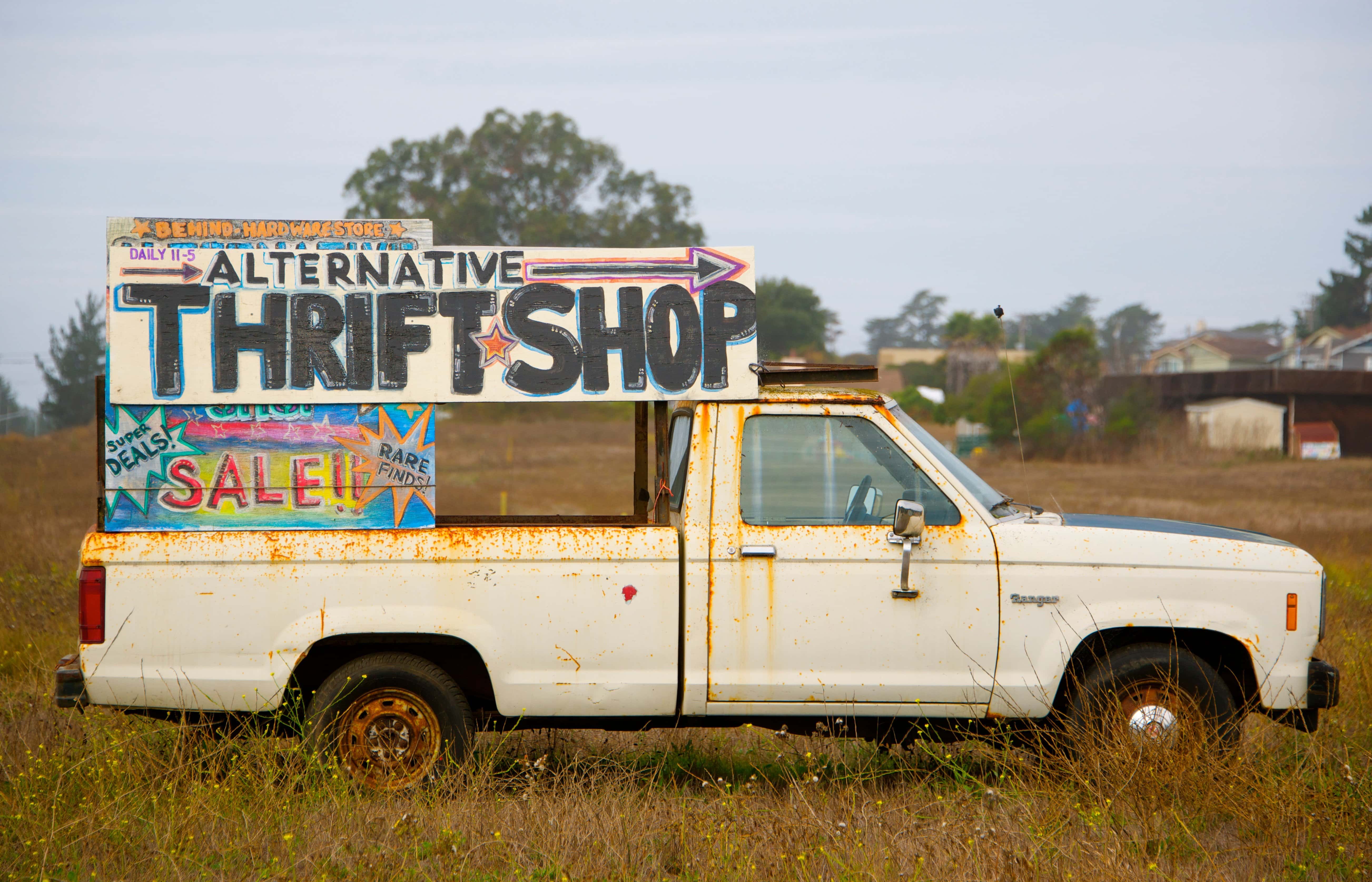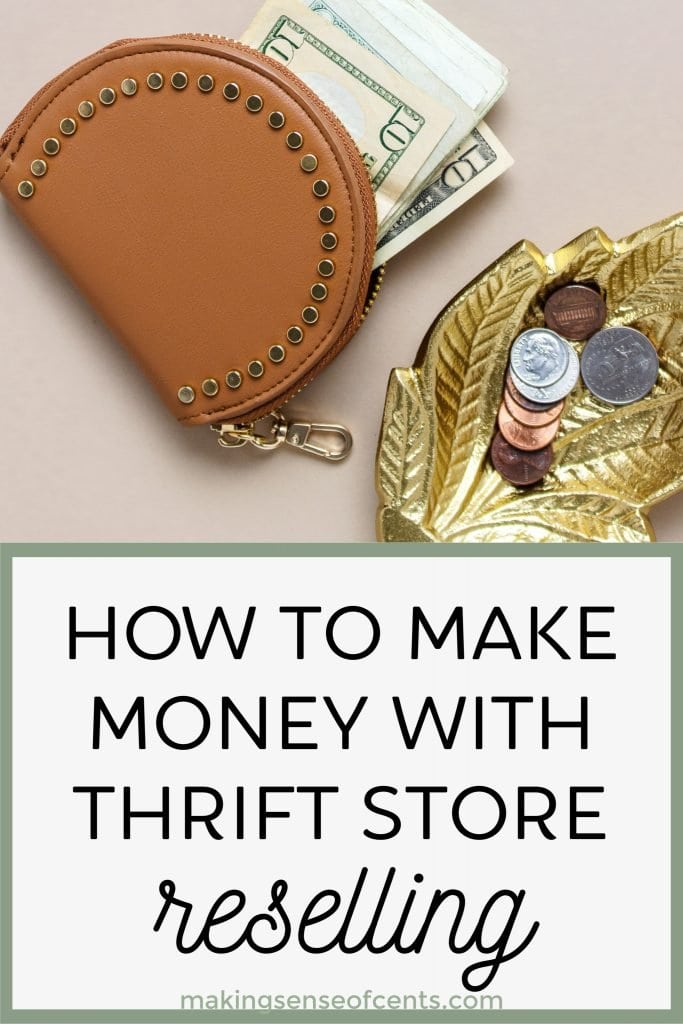Thrift store reselling is when you purchase items from a thrift store and resell them somewhere else for more than you paid for them. You can resell clothing, shoes, accessories, furniture, home decor, and more. And, it can be an interesting way to make extra money.
When I was younger, I worked in a popular secondhand clothing shop called Plato’s Closet. We mainly sold brand name, young adult clothing. And when I worked there, I met many, many people who would scour our racks looking for items to resell.
I also met many people who purchased items from yard sales and charity shops just to sell to us. Many of these same people also went to garage sales and thrift stores like Goodwill in order to find items for thrift store reselling.
I saw a lot of thrift store reselling going on. Some people did it for a full-time income, and other people did it as a way to make money on the side.
And, some did it because they loved finding treasure and going on a hunt.
Sometimes people would score big, and other times they would make only make just a few dollars.
I worked at Plato’s Closet for many years, starting as a sales associate and eventually becoming a manager, and not a day went by when I didn’t see someone doing thrift store flipping.
One of the things I loved about working in a resale shop is that I love a good deal, and it made me really happy to see so many other people saving money on clothes. We saw lots of high-quality clothing and brand name accessories coming in and being sold for a fraction of the price you would see at a traditional retail store.
After so many years of working in a secondhand shop, it’s still hard for me to pay full price for clothing because I know you can probably find nearly the exact same item somewhere else for much cheaper.
But, buying secondhand doesn’t just save you a ton of money, it prevents waste and reduces the amount of things that pile up in landfills.
I think we are all aware that we are throwing things into landfills at alarming rates, and shopping secondhand can be one of many ways to make a difference. It’s a small step towards reducing the negative impact we have on the environment.
Buying secondhand isn’t just good for your budget, it’s good for the earth.
However, that’s not how some people see shopping at thrift stores, especially if you are purchasing items because you plan on thrift store reselling.
I have been told by people that thrift store reselling is taking items that people with less money could have bought and used.
I’ve also heard that people who shop at thrift stores in order to flip items for a higher profit are “evil.”
Other comments I’ve heard about shopping at thrift stores and thrift store flipping include (these are all direct quotes):
- “Why donate if it’s not going to poor people?”
- “Resellers shouldn’t be allowed in charity stores.”
- “Shopping at thrift stores is for people who can’t afford clothes.”
- “The wealthy shouldn’t be allowed to save money. They should leave it for the less fortunate.”
Personally, I believe that thrift stores and discounts are for anyone to use. Of course, everyone is allowed to have their own opinion, but I would bet that those people don’t really understand the positives of purchasing secondhand or the missions that non-profit secondhand stores have.
For those who disagree with thrift store reselling, I would say this – if it somehow encourages more people to buy used instead of new, we are reducing the amount of stuff that ends up in landfills.
If you want to learn more about thrift store reselling and flipping items for profit, I recommend reading these posts:
- How to Make Extra Money with a Flea Market Booth
- How Melissa Made $40,000 In One Year Flipping Items
- How We’ve Turned A Free Chair Into $103,000
- 7 Items You Should And Shouldn’t Buy Used
- How To Work From Home Selling On Amazon FBA
- How To Sell Your Stuff
Here is why I believe thrift store reselling helps everyone.

Thrift store reselling helps the environment.
When resellers come in and comb through the racks at thrift stores, they are finding new homes for the items.
Thrift stores usually have an overwhelming number of things and are usually bursting at the seams. It’s not like you are going to buy 100% of the items in the store – they usually have TOO MANY items to sell. Sometimes thrift stores have so many items that they can’t take any more donations until they sell more of what they have. Stores like Goodwill go to great lengths to keep things from going to the landfill, like selling items by the pound in outlets or sending clothes to textile recyclers.
Still, there are lots of items that end up in landfills.
According to the Environmental Protection Agency, there were 16 million tons of textile waste produced in 2015, and 85% of it went to landfills. The main source of this waste is clothing, with 11.9 million tons of clothing and footwear waste in 2015.
And, according to the Huffington Post, Americans, on average, throw away 81 pounds of clothing each year.
According to Down To Earth Materials, the estimated decomposition time for clothing and other items are:
- Leather shoes: 25-40 years
- Nylon clothes: 30-40 years
- Cotton: 1-5 months
- Tin cans: around 50 years
- Plastic bottles: 70-450 years
As you can see, the clothing we wear and other household items we use can have a big environmental impact. By purchasing secondhand clothing, even if you are reselling thrift store items, you are helping to reduce the amount of waste we put in to landfills and help the environment well into the future.
With more people shopping at thrift stores and purchasing secondhand clothing from resellers, there are even more items that are getting a second “life” and even fewer items ending up in landfills.
Can you just imagine how crazy landfills would be if resellers weren’t allowed to shop at thrift stores? There would be so much more waste that existed!
There’s just SO MUCH STUFF.
For the most part, buying a t-shirt at Goodwill or Salvation Army to resell it isn’t going to negatively impact anyone – thrift stores have plenty of everything. In some places, they are actually turning away donations because they have TOO MUCH STUFF.
When we donated about 99% of our belongings to move into the RV, we took a lot of our things to thrift stores. Surprisingly, a lot of our belongings were rejected because they had too much stuff or too many of a specific item. We actually had to hunt for places that would take some of our stuff.
Most of the things that are sold for thrift store reselling aren’t going to be life or death for anyone – it’s just stuff and there is a lot of it. There are always going to be more shoes, clothes, and household items.
If you go to thrift stores enough, especially the same ones over and over again, you’ll find that there is always new stuff on the racks. Most Americans love buying new things, they do it every season, and that means thrift stores are constantly getting gently used items.
There is plenty for everyone and thrift stores won’t be running out of basic household items and clothing anytime soon.
So, the belief that “resellers are taking away items from the less fortunate” is not realistic – there’s plenty of stuff for everyone. Like I said, thrift stores are bursting with so much stuff that they are turning donations away!
Related content:
- 15 Reasons You’re Broke And Can’t Save Money
- 30+ Ways To Save Money Each Month
- 8 Things To Sell To Make Money
- How To Ditch The Revolving Debt Cycle
It’s all about the thrift store’s mission.
Thrift stores like Goodwill and Salvation Army exist so that they can make money and put that money towards the charities they support.
So, having more people shopping at these thrift stores can help further their mission of helping the community.
For example, with the money Goodwill makes through selling items at its stores and through donations they were able to help more than 242,000 people receive valuable job training in 2018. Goodwill also helped them with transportation, child care, and English language learning.
It’s possible that if you took away some of their customer base, they may not have been able to help as many people. They even state on their website:
“When you donate your new and gently used items to Goodwill®, we sell them in our stores or on our online auction site and use the revenue generated to fund valuable employment training and job placement services for people in your community.”
For many non-profit thrift stores, their mission isn’t to solely sell clothes at low prices. Instead, their mission is to further improve the community and the people in it. To do that, they need funds, and they raise funds by selling donated items.
So, the more people who shop at these stores (including people who are thrift store reselling), the more money they have to further their mission.
How to start thrift store reselling.
If you think you’d like to start reselling thrift store items as a way to earn more money, here are some tips to help you get started.
Pay attention to trends and brands.
You can follow fashion blogs or influencers to learn what trends and brands are currently popular. Right now, vintage finds and clothes from the 90’s are pretty popular. Also, high-quality outdoor clothing brands always seem to sell well.
Carefully look over each item before purchasing.
When I worked at Plato’s Closet, I learned how to carefully inspect clothing before we bought it from sellers. We looked for rips, torn seams, stains, frayed edges, worn spots, etc. While I mainly did that for clothing and shoes, paying attention to the wear and tear of furniture or other resale items is just as important.
Even though people know they are buying used, they still want it to look decent. Examining your finds is important whether you are Goodwill reselling, finding things at other secondhand shops, purchasing from garage sales, etc.
Here are some tips for looking over items to resell:
- Shirts and tops: Check for armpit and collar stains, missing buttons, and frayed or stained cuffs.
- Jeans and pants: Look for worn spots near the back pockets and near the crotch, check to see that pockets don’t have holes, and look for frayed cuffs.
- Shoes: Examine the soles, laces, and inside of the shoe.
- Furniture: Look at the legs of chairs and tables for scratches, see if things wobble, check wood items for water stains and knicks, and look over cloth items for stains or odors.
Be honest when listing your items.
Items in excellent condition will usually sell the best, but as long as you are honest in your listings you may be able to sell things that look a little more used. And, being honest can help your ratings on apps and other online seller platforms.
For example, if you are selling thrift store items on eBay, you should mention any issues and show a photo of each of them. A potential buyer can decide if the price is worth buying the item, potentially fixing the issue or just living with it.
Apps that make it even easier to resell thrift store items.
There are lots of apps that make thrift store reselling easy, so here are some popular apps to sell on:
- Poshmark
- Depop
- Facebook Marketplace
- 5miles
- Charish (furniture and home decor only)
- Vinted
- Instagram (people with large following often sell in IG Stories)
What do you think? Do you think that thrift stores shouldn’t be used for thrift store reselling?
Recommended reading: 27 Best Consignment Stores Near Me And Online



Leave a Reply